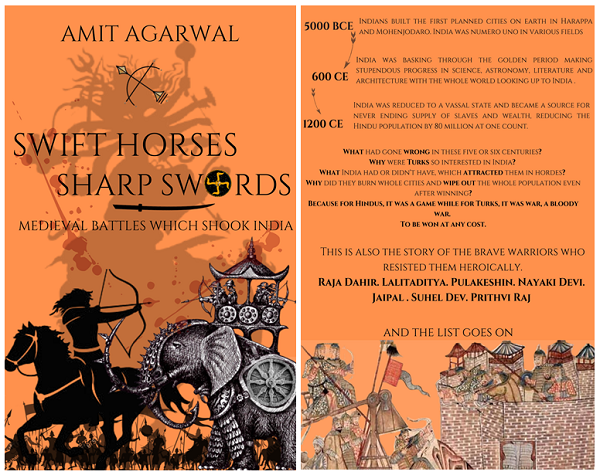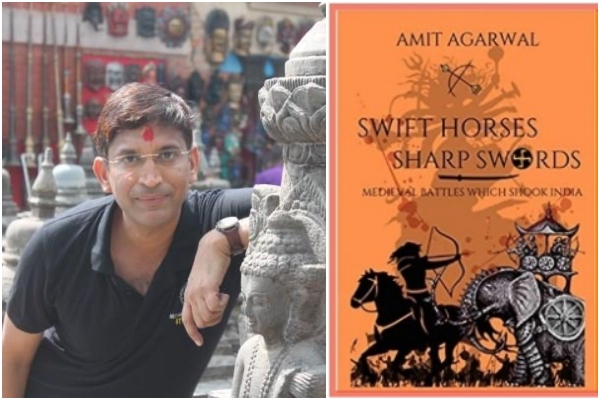Swift Horses Sharp Swords- An amazing way to now history from a Hindu perspective
Total Views |
In the book titled “Swift Horses Sharp Swords,” author Amit Agarwal strives to offer a complete 360 degree view of one of the bloodiest and longest conquests of the world. This book is the concise and compact history of India, especially of the early medieval era. It is fast-paced and modelled on the format of thrillers. Author manages to keep the readers’ interest alive and the book can be finished in flat 2 to 3 days. Unlike other history books, this book does not bore you and does not make you skip any pages. It's quite comprehensive in the vastness of time frame covered, the chapter headings are interesting and the following material is informative. The illustrations whether it be maps, data and charts give it a well-defined look.
Another exciting aspect of the book is that it is written from a Hindu perspective, unlike others which had been written with a left liberal narrative and designed to make Hindus inferior. Though this is the author’s first book yet he managed to give a unique perspective and ideas. The author is a mechanical engineering graduate from IIT- Roorkee, yet he seemed to have keen interest in history. Since the book is written by an engineer, it has science and maths besides social, religious, geography, polity and economic parameters running through its veins and the reader will be transported back to that turbulent era.

It begins with the first Muslim conquest by Mohammed bin Qasim at the start of the 8th century and ends with Ghori’s invasion of Hindustan, leading to establishment of the Delhi Sultanate which remained in power for almost three centuries until Mughals invaded. It has a chapter on Kashmir also which gives the summary of terrifying events in the region. There have been the seven waves of exodus of Hindus from Kashmir and there won’t be any more as there are no more Hindus left there. The book also has a chapter on Bakhtiyar Khilji who was instrumental in burning world-famed Nalanda University. He then proceeded on the rampant conversion of Hindus in Bengal in 12th century and the killing of thousands of Hindus. Today he is considered as a founding father in Bangladesh. The book also tells the brave story of an Assam ruler who managed to defeat Khilji when he tried to invade Sikkim and Bhutan.
The book starts with Indus valley civilization from 8000 BCE till its abrupt demise sometime in 3000 BCE. Afterwards the book veers towards the advent of Aryan wherein three theories have been explained namely Aryan migration, invasion and out-of-India. Aryan invasion theory has been thoroughly debunked while there has been dispute between migration and out-of-India theory. In later chapters, the author dealt with the glory and success of India in that era. Author has given an authentic table by which it is now known that India produced a massive 25% of the world’s GDP till the 5th century! Though this is not the part of the medieval era, the author is probably building up a contrast with a more tumultuous medieval period. After the invasion of Arabs, Turks and Mughals started in the early medieval era, however, a steep decline in the social and political life commenced, however we were still the most economically advanced country till the arrival of British. It was latter who drained India of all its wealth and spawned various famines, which was once considered the food bowl of the world.
The book has many analytical comparisons between various types of battles- even with European ones- followed by an broad discussion on the rise and decline of Hinduism alongside the emergence, propagation and then demise of Buddhism, not only seem trustworthy but are also supported with suitable citations from the relevant sources. The book then veers towards its main subject: early Indian medieval history which spanned from 7th century to 12th century which changed the very trajectory of India. There is comprehensive analysis of the invasions and their results.
The author stresses on the fact that backwardness in the military technology was the main reason behind the debacle, while other historians normally blame disunity among the Hindu rulers. There was no dearth of bravery among Hindu warriors and a lot of them are given due respect in the book. He points out that when the whole landmass of Bharatvarsha was under one kingdom e.g. Rashtrakutas, the Pratihara and the Chalukyas, no invasion happened making the period between 8th and 11th century relatively peaceful. He has provided authentic data of wealth looted and temples plundered during the era, which should open our eyes at least now.

The end part primarily deals with the complete analysis and stimulating anecdotes. A chapter even discusses the role of elephants and horses in the battles and their discomfort about such violent interactions between the humans which are not found in the animal world. There are some other unique chapters based on Game Theory and Networking to explain the Survival of Hinduism. Other ancient civilizations like Egypt, Greek and Mesopotamia were crushed by Christianity and Islam. The book ends with a brief overview of the dreadful partition of India and examines the culpability of all the three powers e.g. Congress, Muslim League and British government.
However, there is still some room for improvement in the book. The presentation of this nice book could have been certainly better in the department of printing. Although it does not interfere, in any sense, with the great content that it has. The book could also have been a little shorter. Author has also stated that similar conditions still exist and it is important to know our strengths and weaknesses. Those who know the past, design the future.
Finally, the book is breath-taking in historical sweep, deep in analysis and by using modern tools of investigation, tries to present the bygone era in front of us. Overall, I found the book to be interesting, informative and wanting to explore a few topics and that is the beauty of any book, of wanting to know more. I request the author to keep his writing pen moving. Wishing him the very best for more books to come.
Reviewed by- VishnuKant Saxena
The reviewer, a sanatani, is an engineer and MBA and works as a senior manager in a leading private bank. He writes short stories in English and Hindi.
.
.